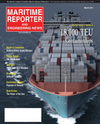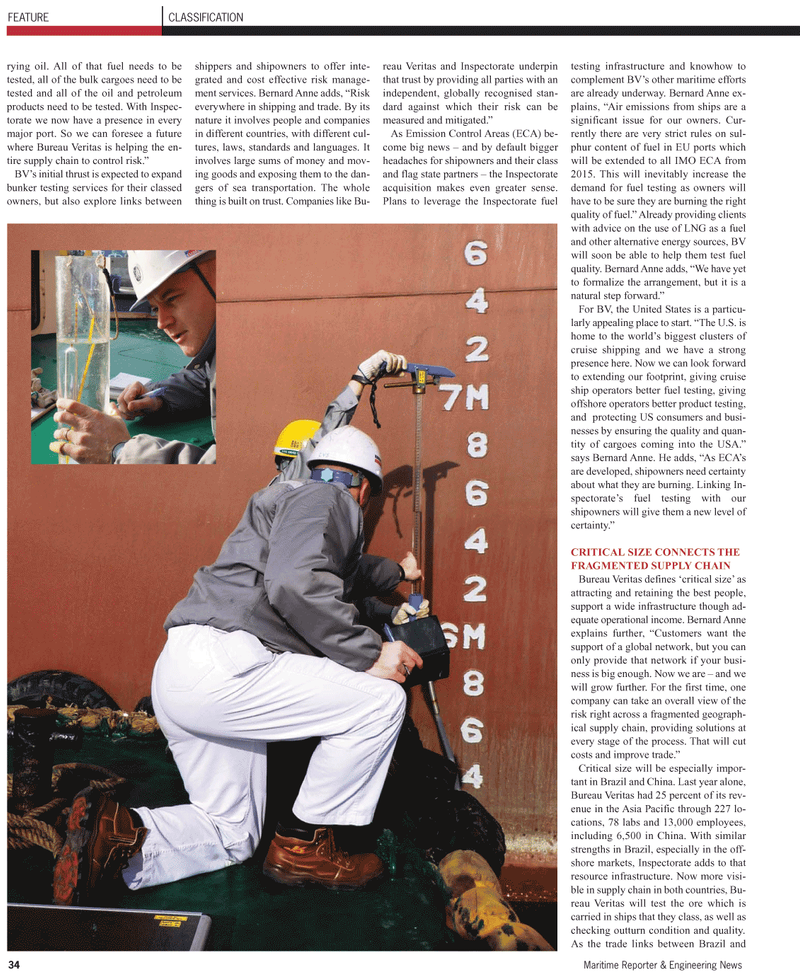
Page 34: of Maritime Reporter Magazine (March 2011)
Ship Repair & Conversion
Read this page in Pdf, Flash or Html5 edition of March 2011 Maritime Reporter Magazine
FEATURE CLASSIFICATION 34 Maritime Reporter & Engineering News rying oil. All of that fuel needs to be tested, all of the bulk cargoes need to be tested and all of the oil and petroleum products need to be tested. With Inspec- torate we now have a presence in every major port. So we can foresee a future where Bureau Veritas is helping the en- tire supply chain to control risk.”
BV’s initial thrust is expected to expand bunker testing services for their classed owners, but also explore links between shippers and shipowners to offer inte- grated and cost effective risk manage- ment services. Bernard Anne adds, “Risk everywhere in shipping and trade. By its nature it involves people and companies in different countries, with different cul- tures, laws, standards and languages. It involves large sums of money and mov- ing goods and exposing them to the dan- gers of sea transportation. The whole thing is built on trust. Companies like Bu- reau Veritas and Inspectorate underpin that trust by providing all parties with an independent, globally recognised stan- dard against which their risk can be measured and mitigated.”
As Emission Control Areas (ECA) be- come big news – and by default bigger headaches for shipowners and their class and flag state partners – the Inspectorate acquisition makes even greater sense.
Plans to leverage the Inspectorate fuel testing infrastructure and knowhow to complement BV’s other maritime efforts are already underway. Bernard Anne ex- plains, “Air emissions from ships are a significant issue for our owners. Cur- rently there are very strict rules on sul- phur content of fuel in EU ports which will be extended to all IMO ECA from 2015. This will inevitably increase the demand for fuel testing as owners will have to be sure they are burning the right quality of fuel.” Already providing clients with advice on the use of LNG as a fuel and other alternative energy sources, BV will soon be able to help them test fuel quality. Bernard Anne adds, “We have yet to formalize the arrangement, but it is a natural step forward.”
For BV, the United States is a particu- larly appealing place to start. “The U.S. is home to the world’s biggest clusters of cruise shipping and we have a strong presence here. Now we can look forward to extending our footprint, giving cruise ship operators better fuel testing, giving offshore operators better product testing, and protecting US consumers and busi- nesses by ensuring the quality and quan- tity of cargoes coming into the USA.” says Bernard Anne. He adds, “As ECA’s are developed, shipowners need certainty about what they are burning. Linking In- spectorate’s fuel testing with our shipowners will give them a new level of certainty.”
CRITICAL SIZE CONNECTS THE
FRAGMENTED SUPPLY CHAIN
Bureau Veritas defines ‘critical size’ as attracting and retaining the best people, support a wide infrastructure though ad- equate operational income. Bernard Anne explains further, “Customers want the support of a global network, but you can only provide that network if your busi- ness is big enough. Now we are – and we will grow further. For the first time, one company can take an overall view of the risk right across a fragmented geograph- ical supply chain, providing solutions at every stage of the process. That will cut costs and improve trade.”
Critical size will be especially impor- tant in Brazil and China. Last year alone,
Bureau Veritas had 25 percent of its rev- enue in the Asia Pacific through 227 lo- cations, 78 labs and 13,000 employees, including 6,500 in China. With similar strengths in Brazil, especially in the off- shore markets, Inspectorate adds to that resource infrastructure. Now more visi- ble in supply chain in both countries, Bu- reau Veritas will test the ore which is carried in ships that they class, as well as checking outturn condition and quality.
As the trade links between Brazil and

 33
33

 35
35
